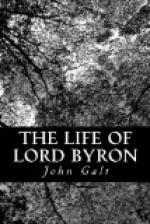There were two islands in the Archipelago, when Lord Byron was in Greece, considered as the chief haunts of the pirates, Stampalia, and a long narrow island between Cape Colonna and Zea. Jura also was a little tainted in its reputation. I think, however, from the description, that the pirate’s isle of The Corsair is the island off Cape Colonna. It is a rude, rocky mass. I know not to what particular Coron, if there be more than one, the poet alludes; for the Coron of the Morea is neighbour to, if not in, the Mainote territory, a tract of country which never submitted to the Turks, and was exempted from the jurisdiction of Mussulman officers by the payment of an annual tribute. The Mainotes themselves are all pirates and robbers. If it be in that Coron that Byron has placed Seyd the pasha, it must be attributed to inadvertency. His Lordship was never there, nor in any part of Maina; nor does he describe the place, a circumstance which of itself goes far to prove the inadvertency. It is, however, only in making it the seat of a Turkish pasha that any error has been committed. In working out the incidents of the poem where descriptions of scenery are given, they relate chiefly to Athens and its neighbourhood. In themselves these descriptions are executed with an exquisite felicity; but they are brought in without any obvious reason wherefore. In fact, they appear to have been written independently of the poem, and are patched on “shreds of purple” which could have been spared.
The character of Conrad the Corsair may be described as a combination of the warrior of Albania and a naval officer—Childe Harold mingled with the hero of The Giaour.
A man of loneliness and mystery,
Scarce seen to smile, and seldom heard to sigh;
Robust, but not Herculean, to the sight,
No giant frame sets forth his common height;
Yet in the whole, who paused to look again
Saw more than marks the crowd of vulgar men:
They gaze and marvel how, and still confess
That thus it is, but why they cannot guess.
Sun-burnt his cheek, his forehead high and pale,
The sable curls in wild profusion veil.
And oft perforce his rising lip reveals
The haughtier thought it curbs, but scarce conceals:
Though smooth his voice, and calm his general mien,
Still seems there something he would not have seen.
His features’ deepening lines and varying hue
At times attracted, yet perplex’d the view,
As if within that murkiness of mind
Work’d feelings fearful, and yet undefined:
Such might he be that none could truly tell,
Too close inquiry his stern glance could quell.
There breathed but few whose aspect could defy
The full encounter of his searching eye;
He had the skill, when cunning gaze to seek
To probe his heart and watch his changing cheek,
At once the observer’s purpose to espy,
And on himself roll back his scrutiny,
Lest he to Conrad rather should betray
Some secret thought, than drag that chief’s
to day.




